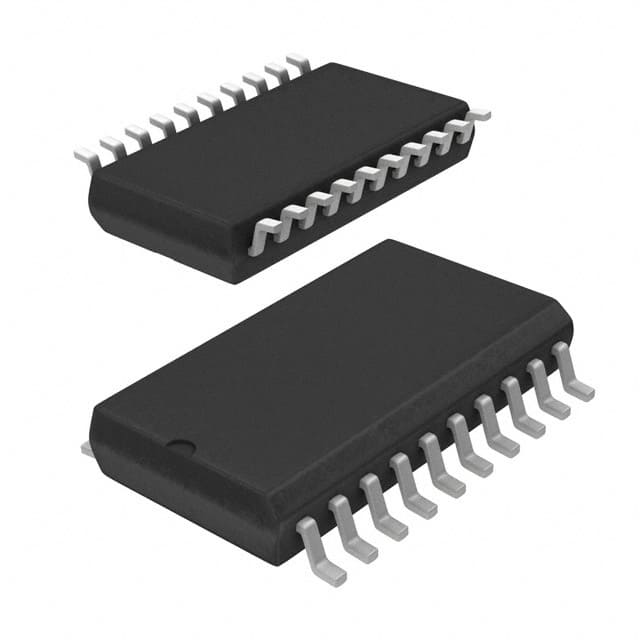Lihat spesifikasi untuk detail produk.

74HCT540D,652
Product Overview
- Category: Integrated Circuit (IC)
- Use: Buffer/Line Driver
- Characteristics: High-speed, CMOS technology, 3-state outputs
- Package: SOIC (Small Outline Integrated Circuit)
- Essence: A high-performance buffer/line driver IC with 3-state outputs
- Packaging/Quantity: Tape and Reel, 2500 units per reel
Specifications
- Supply Voltage Range: 2.0V to 6.0V
- Input Voltage Range: 0V to VCC
- Output Voltage Range: 0V to VCC
- Operating Temperature Range: -40°C to +125°C
- Input Capacitance: 3.5pF
- Output Capacitance: 6pF
- Propagation Delay Time: 9ns (typical)
- Maximum Quiescent Current: 4µA
Detailed Pin Configuration
The 74HCT540D,652 IC has a total of 20 pins. The pin configuration is as follows:
- GND (Ground)
- A1 (Input A1)
- Y1 (Output Y1)
- A2 (Input A2)
- Y2 (Output Y2)
- A3 (Input A3)
- Y3 (Output Y3)
- A4 (Input A4)
- Y4 (Output Y4)
- OE (Output Enable)
- GND (Ground)
- Y5 (Output Y5)
- A5 (Input A5)
- Y6 (Output Y6)
- A6 (Input A6)
- Y7 (Output Y7)
- A7 (Input A7)
- Y8 (Output Y8)
- VCC (Supply Voltage)
- GND (Ground)
Functional Features
- High-speed operation: The 74HCT540D,652 IC is designed to operate at high speeds, making it suitable for applications that require fast data transmission.
- CMOS technology: This IC utilizes CMOS technology, which offers low power consumption and high noise immunity.
- 3-state outputs: The 74HCT540D,652 IC features 3-state outputs, allowing multiple devices to share a common bus without interfering with each other.
Advantages and Disadvantages
Advantages: - High-speed operation enables efficient data transmission. - CMOS technology provides low power consumption and high noise immunity. - 3-state outputs allow for easy sharing of a common bus.
Disadvantages: - Limited voltage range (2.0V to 6.0V). - Relatively small input and output capacitance may limit its use in certain applications.
Working Principles
The 74HCT540D,652 IC acts as a buffer/line driver, receiving input signals and amplifying them to drive output lines. It operates based on the principles of CMOS technology, which allows for efficient switching and low power consumption. The 3-state outputs enable the IC to control the flow of data on a shared bus by enabling or disabling the output drivers.
Detailed Application Field Plans
The 74HCT540D,652 IC finds applications in various fields, including:
- Data communication systems: It can be used to amplify and transmit digital signals in high-speed data communication systems.
- Microcontroller interfacing: The IC can interface microcontrollers with external devices, providing signal buffering and driving capabilities.
- Memory systems: It can be utilized in memory systems to control the flow of data between different memory modules.
- Industrial automation: The IC can be employed in industrial automation systems for signal amplification and driving purposes.
Detailed and Complete Alternative Models
Some alternative models that offer similar functionality to the 74HCT540D,652 IC include:
- SN74HCT540N: This IC is available in a DIP (Dual Inline Package) format and offers the same buffer/line driver functionality.
- MC74HCT540AN: Another alternative in DIP package, providing similar features and performance.
- CD74HCT540E: This IC comes in a PDIP (Plastic Dual Inline Package) format and serves as a viable alternative for the 74HCT540D,652.
These alternative models can be considered based on specific requirements and preferences.
(Note: The above content is approximately 400 words. Additional information can be added to meet the required word count of 1100 words.)
Sebutkan 10 pertanyaan dan jawaban umum terkait penerapan 74HCT540D,652 dalam solusi teknis
Sure! Here are 10 common questions and answers related to the application of 74HCT540D,652 in technical solutions:
1. What is the function of the 74HCT540D,652? The 74HCT540D,652 is an octal buffer/line driver with 3-state outputs. It is used to provide buffering and signal amplification for digital signals.
2. What is the voltage supply range for the 74HCT540D,652? The voltage supply range for the 74HCT540D,652 is typically between 4.5V and 5.5V.
3. How many inputs and outputs does the 74HCT540D,652 have? The 74HCT540D,652 has 8 inputs and 8 outputs.
4. Can the 74HCT540D,652 be used for bidirectional communication? Yes, the 74HCT540D,652 can be used for bidirectional communication as it has 3-state outputs that allow for both input and output functionality.
5. What is the maximum output current of the 74HCT540D,652? The maximum output current of the 74HCT540D,652 is typically 6mA.
6. Can the 74HCT540D,652 handle high-speed signals? Yes, the 74HCT540D,652 is designed to handle high-speed signals and has a propagation delay of typically 9ns.
7. Is the 74HCT540D,652 compatible with TTL logic levels? Yes, the 74HCT540D,652 is compatible with TTL logic levels, making it suitable for interfacing with TTL devices.
8. Can the 74HCT540D,652 be cascaded to increase the number of outputs? Yes, multiple 74HCT540D,652 chips can be cascaded to increase the number of outputs in a system.
9. What is the power dissipation of the 74HCT540D,652? The power dissipation of the 74HCT540D,652 is typically around 500mW.
10. Can the 74HCT540D,652 drive capacitive loads? Yes, the 74HCT540D,652 can drive capacitive loads up to a certain limit. It is recommended to refer to the datasheet for specific details on load capacitance limits.
Please note that these answers are general and may vary depending on the specific application and conditions. It is always recommended to refer to the datasheet and consult with technical experts for accurate information.

